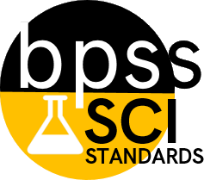SCI-03.ESS2
|
SCI-03.ESS2.01SCI-03.ESS2.01 Represent data in tables and graphical displays to describe and predict typical weather conditions expected during a particular season.Clarification Statement: Examples of data could include average temperature, precipitation, and wind direction.
|
SCI-03.ESS2.02
SCI-03.ESS2.02 Obtain and combine information to describe climates in different regions of the world.Clarification Statement: Examples of climate in different regions, how climate predicts weather conditions, and climate variations
around the world. Student Learning Targets:Knowledge Targets
Reasoning Targets
Skills (Performance) Targets
Product Targets
Proficiency ScaleThe Student ...1 Beginning... with help, demonstrates a partial understanding of some of the simpler details and processes (Score 2.0 content) and some of the more complex ideas and processes (Score 3.0 content).
2 Developing... demonstrates no major errors or omissions regarding the simpler details and processes but exhibits major errors or omissions regarding the more complex ideas and processes (Score 3.0 content).
3 Proficient“The Standard.”... demonstrates no major errors or omissions regarding any of the information and processes that were end of instruction expectations.
4 Advanced... demonstrates in-depth inferences and applications regarding more complex material that go beyond end of instruction expectations.
ResourcesVocabulary
Websites
|
SCI-03.ESS3
|
SCI-03.ESS3.01
SCI-03.ESS3.01 Evaluate the feasibility of a design solution that reduces the impacts of a weather-related hazard.Clarification Statement: Examples of design solutions to weather-related hazards could include barriers to prevent flooding and
wind resistant roofs Student Learning Targets:Knowledge Targets
Reasoning Targets
Skills (Performance) Targets
Product Targets
Proficiency ScaleThe Student ...1 Beginning... with help, demonstrates a partial understanding of some of the simpler details and processes (Score 2.0 content) and some of the more complex ideas and processes (Score 3.0 content).
2 Developing... demonstrates no major errors or omissions regarding the simpler details and processes but exhibits major errors or omissions regarding the more complex ideas and processes (Score 3.0 content).
3 Proficient“The Standard.”... demonstrates no major errors or omissions regarding any of the information and processes that were end of instruction expectations.
4 Advanced... demonstrates in-depth inferences and applications regarding more complex material that go beyond end of instruction expectations.
ResourcesVocabulary
Websites
|
SCI-03.LS1
|
SCI-03.LS1.01SCI-03.LS1.01 Develop models to describe that organisms have unique and diverse life cycles but all experience birth, growth, reproduction, and death.Clarification Statement: Changes organisms go through during their life form a pattern
|
SCI-03.LS2
|
SCI-03.LS2.01
SCI-03.LS2.01 Construct an argument that some animals form groups that help members survive.Clarification Statement: Being part of a group helps animals obtain food, defend themselves, and cope with changes. Groups may
serve different functions and vary dramatically in size. Student Learning Targets:Knowledge Targets
Reasoning Targets
Skills (Performance) Targets
Product Targets
Proficiency ScaleThe Student ...1 Beginning... with help, demonstrates a partial understanding of some of the simpler details and processes (Score 2.0 content) and some of the more complex ideas and processes (Score 3.0 content).
2 Developing... demonstrates no major errors or omissions regarding the simpler details and processes but exhibits major errors or omissions regarding the more complex ideas and processes (Score 3.0 content).
3 Proficient“The Standard.”... demonstrates no major errors or omissions regarding any of the information and processes that were end of instruction expectations.
4 Advanced... demonstrates in-depth inferences and applications regarding more complex material that go beyond end of instruction expectations.
ResourcesVocabulary
Websites
|
SCI-03.LS3
|
SCI-03.LS3.01
SCI-03.LS3.01 Analyze and interpret data to provide evidence that plants and animals have traits inherited from parents and that variation of these traits exists in a group of similar organisms.Clarification Statement: Patterns are the similarities and differences in traits shared between offspring and their parents, or among
siblings. Emphasis is on organisms other than humans. Student Learning Targets:Knowledge Targets
Reasoning Targets
Skills (Performance) Targets
Product Targets
Proficiency ScaleThe Student ...1 Beginning... with help, demonstrates a partial understanding of some of the simpler details and processes (Score 2.0 content) and some of the more complex ideas and processes (Score 3.0 content).
2 Developing... demonstrates no major errors or omissions regarding the simpler details and processes but exhibits major errors or omissions regarding the more complex ideas and processes (Score 3.0 content).
3 Proficient“The Standard.”... demonstrates no major errors or omissions regarding any of the information and processes that were end of instruction expectations.
4 Advanced... demonstrates in-depth inferences and applications regarding more complex material that go beyond end of instruction expectations.
ResourcesVocabulary
Websites
|
SCI-03.LS3.02SCI-03.LS3.02 Use evidence to support the explanation that the expression of traits can be influenced by the environment.Clarification Statement: Examples of the environment affecting a trait could include normally tall plants grown with insufficient
water are stunted. A person born healthy based on their genetics could suffer from the exposure to toxic
chemicals
|
 DCI Earth Space Science ESS2
DCI Earth Space Science ESS2